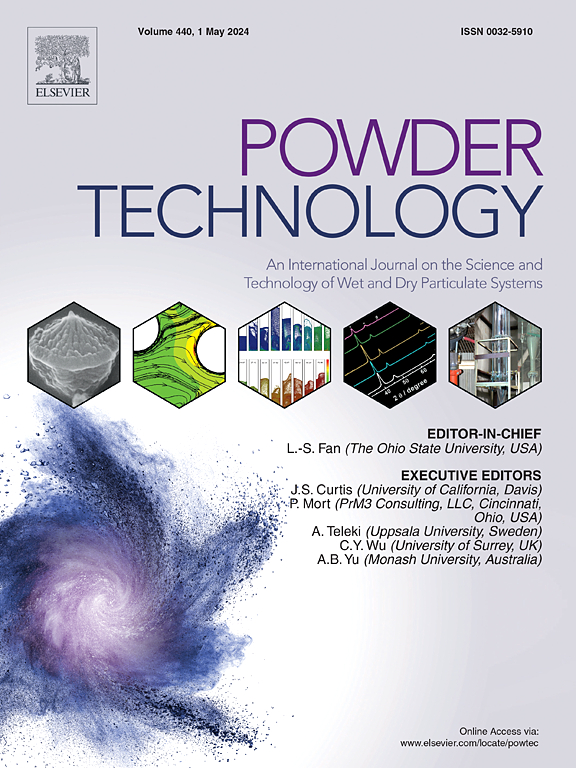Synergistic effect of alkali metals and fluorine on the reduction swelling properties of pellet ores: Influence of basicity
IF 4.5
2区 工程技术
Q2 ENGINEERING, CHEMICAL
引用次数: 0
Abstract
Bayan Obo iron ore concentrate is a crucial raw material in steel production, but its high content of harmful elements like alkali metals and fluorine (F) affects the reduction swelling properties of pellet ores. This study aimed to clarify these effects at different basicity by simulating Bayan Obo iron ore concentrate using synthetic reagents. Comprehensive investigations were conducted using a high-temperature deformation analyzer, X-ray diffraction (XRD), scanning electron microscopy with energy-dispersive spectroscopy (SEM-EDS), and thermogravimetric analysis to explore the reduction swelling process, phase crystal structure, microstructure, and kinetic behavior during reduction. The results showed that under the different basicity and reduction conditions, pellet ores containing Na and F exhibited a higher reduction swelling index than those pellet ores containing K and F. The maximum total reduction swelling index for both types of pellet ores occurred at a basicity of 0.8, with values of 50.6 % and 96.5 %, respectively. Additionally, a detrimental synergistic effect between Na and F was observed, which promoted the incorporation of alkali metals into the iron oxide lattice, leading to higher lattice constants, residual stresses, and distortion. The iron whiskers in the pellet ores containing Na and F formed a coarse reticular structure, indicating a synergistic effect of Na and F in promoting the growth of iron whiskers. Thermogravimetric and kinetic analysis indicated that the synergistic interaction between Na and F decreased the initial and final reaction temperatures of the pellet ores, reduced the energy required for the reduction reaction, and accelerated the reaction process, which was a key factor in exacerbating the reduction swelling of the pellet ores.

碱金属与氟对球团矿还原溶胀性能的协同作用:碱度的影响
白云鄂博铁矿精矿是钢铁生产的重要原料,但其碱金属、氟(F)等有害元素含量高,影响了球团矿的还原膨胀性能。本研究旨在利用合成试剂模拟白云鄂博铁矿精矿,阐明不同碱度下的影响。采用高温变形分析仪、x射线衍射仪(XRD)、扫描电镜-能谱仪(SEM-EDS)和热重分析等手段对还原膨胀过程、相晶结构、微观结构和还原动力学行为进行了全面研究。结果表明:在不同碱度和还原条件下,含Na和F的球团矿的还原膨胀指数高于含K和F的球团矿,两种球团矿的总还原膨胀指数在碱度为0.8时最大,分别为50.6%和96.5%;此外,Na和F之间存在不利的协同效应,促进碱金属进入氧化铁晶格,导致更高的晶格常数、残余应力和畸变。含Na和F的球团矿中铁须形成粗网状结构,说明Na和F在促进铁须生长方面具有协同作用。热重分析和动力学分析表明,Na与F的协同作用降低了球团矿的初始和最终反应温度,降低了还原反应所需的能量,加速了反应过程,是加剧球团矿还原膨胀的关键因素。
本文章由计算机程序翻译,如有差异,请以英文原文为准。
求助全文
约1分钟内获得全文
求助全文
来源期刊

Powder Technology
工程技术-工程:化工
CiteScore
9.90
自引率
15.40%
发文量
1047
审稿时长
46 days
期刊介绍:
Powder Technology is an International Journal on the Science and Technology of Wet and Dry Particulate Systems. Powder Technology publishes papers on all aspects of the formation of particles and their characterisation and on the study of systems containing particulate solids. No limitation is imposed on the size of the particles, which may range from nanometre scale, as in pigments or aerosols, to that of mined or quarried materials. The following list of topics is not intended to be comprehensive, but rather to indicate typical subjects which fall within the scope of the journal's interests:
Formation and synthesis of particles by precipitation and other methods.
Modification of particles by agglomeration, coating, comminution and attrition.
Characterisation of the size, shape, surface area, pore structure and strength of particles and agglomerates (including the origins and effects of inter particle forces).
Packing, failure, flow and permeability of assemblies of particles.
Particle-particle interactions and suspension rheology.
Handling and processing operations such as slurry flow, fluidization, pneumatic conveying.
Interactions between particles and their environment, including delivery of particulate products to the body.
Applications of particle technology in production of pharmaceuticals, chemicals, foods, pigments, structural, and functional materials and in environmental and energy related matters.
For materials-oriented contributions we are looking for articles revealing the effect of particle/powder characteristics (size, morphology and composition, in that order) on material performance or functionality and, ideally, comparison to any industrial standard.
 求助内容:
求助内容: 应助结果提醒方式:
应助结果提醒方式:


